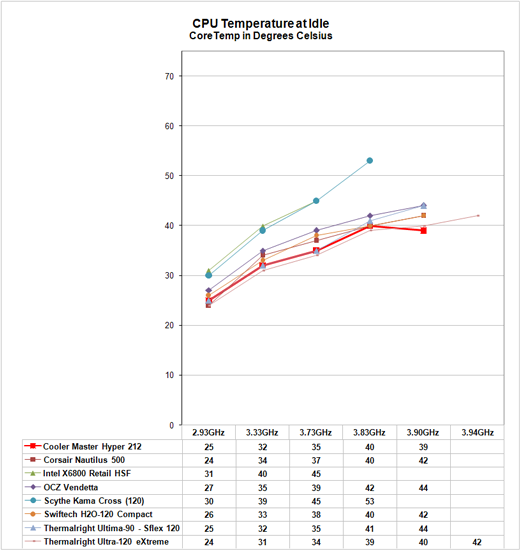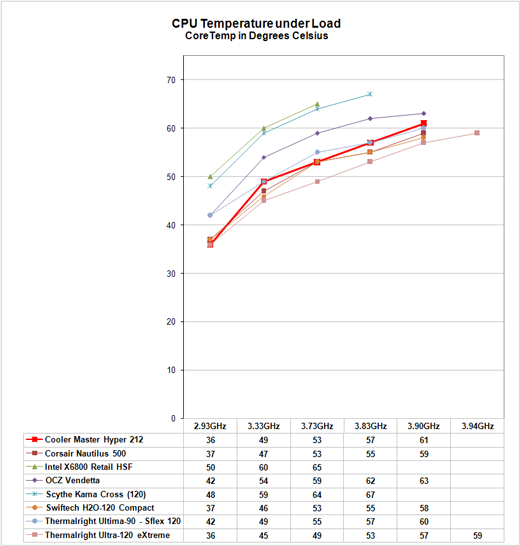Cooler Master Hyper 212: Looking for a Winner
by Wesley Fink on October 31, 2007 2:00 AM EST- Posted in
- Cases/Cooling/PSUs
Scaling of Cooling Performance
With excellent performance at stock speed, the Hyper 212 was pushed in our performance scaling tests to see if this mid-priced air cooler delivered similarly impressive performance when overclocking. In our last review we changed our method of displaying results with a reversed scale. That generated an avalanche of emails asking that we go back to the normal method of displaying scaling results. Therefore charts for the Hyper 212 return to a scale with zero on the bottom and 75C on the top. Keep in mind that the lower line is the best performance in this presentation of the data - lower temperatures represent better performance.
The Cooler Master Hyper 212 at idle is one of the best performing coolers we have tested. Performance is generally on par with the excellent group of coolers that fall just below the Thermalright Ultra-120 eXtreme in performance, like the Tuniq Tower, Scythe Infinity, and Thermalright Ultra-120 and Thermalright Ultima-90 with 120mm fan. Performance is generally better than competing mid-priced coolers, which means the Hyper 212 is a good value.
The performance boost at the 3.90 GHz setting in the chart is because two fans were used to reach a top speed of 3.88 GHz; the single installed fan topped out at 3.83 GHz, which is typical of midrange coolers. The top coolers tested have generally continued on to around 3.90 GHz, though most of the square towers require two fans to reach this performance level.
Cooling efficiency of the Cooler Master Hyper 212 was compared under load conditions to the retail HSF and other recently retested CPU coolers. Load testing can be very revealing of a cooler's efficiency. A basically flat line, particularly form 3.73GHz upward, indicates the cooler is still in its best cooling range. A line that is falling rapidly indicates a cooler nearing the end of its ability to cool efficiently. Lines which parallel the best coolers over a range of values are showing similar efficiency slopes.
Under stress test conditions the performance of the Hyper 212 is more like other mid-priced coolers than the top of tested coolers. It is still the best midrange result we have tested so far, which reinforces the value of the Hyper 212 at a price of around $40. As should be clear in the chart the Hyper 212 significantly outperforms the midrange OCZ Vendetta and Scythe Kama Cross in cooling performance.
The Hyper 212 will not challenge the top coolers like the Thermalright Ultra-120 eXtreme. However, it does outperform almost any other $40 cooler you may be considering which means it is a very good value at that price. With the relatively easy addition of a second fan it even reaches 3.88 GHz, which is close to the performance of the best we have tested.
With excellent performance at stock speed, the Hyper 212 was pushed in our performance scaling tests to see if this mid-priced air cooler delivered similarly impressive performance when overclocking. In our last review we changed our method of displaying results with a reversed scale. That generated an avalanche of emails asking that we go back to the normal method of displaying scaling results. Therefore charts for the Hyper 212 return to a scale with zero on the bottom and 75C on the top. Keep in mind that the lower line is the best performance in this presentation of the data - lower temperatures represent better performance.
 |
The Cooler Master Hyper 212 at idle is one of the best performing coolers we have tested. Performance is generally on par with the excellent group of coolers that fall just below the Thermalright Ultra-120 eXtreme in performance, like the Tuniq Tower, Scythe Infinity, and Thermalright Ultra-120 and Thermalright Ultima-90 with 120mm fan. Performance is generally better than competing mid-priced coolers, which means the Hyper 212 is a good value.
The performance boost at the 3.90 GHz setting in the chart is because two fans were used to reach a top speed of 3.88 GHz; the single installed fan topped out at 3.83 GHz, which is typical of midrange coolers. The top coolers tested have generally continued on to around 3.90 GHz, though most of the square towers require two fans to reach this performance level.
Cooling efficiency of the Cooler Master Hyper 212 was compared under load conditions to the retail HSF and other recently retested CPU coolers. Load testing can be very revealing of a cooler's efficiency. A basically flat line, particularly form 3.73GHz upward, indicates the cooler is still in its best cooling range. A line that is falling rapidly indicates a cooler nearing the end of its ability to cool efficiently. Lines which parallel the best coolers over a range of values are showing similar efficiency slopes.
 |
Under stress test conditions the performance of the Hyper 212 is more like other mid-priced coolers than the top of tested coolers. It is still the best midrange result we have tested so far, which reinforces the value of the Hyper 212 at a price of around $40. As should be clear in the chart the Hyper 212 significantly outperforms the midrange OCZ Vendetta and Scythe Kama Cross in cooling performance.
The Hyper 212 will not challenge the top coolers like the Thermalright Ultra-120 eXtreme. However, it does outperform almost any other $40 cooler you may be considering which means it is a very good value at that price. With the relatively easy addition of a second fan it even reaches 3.88 GHz, which is close to the performance of the best we have tested.










21 Comments
View All Comments
pc007 - Wednesday, October 31, 2007 - link
This is only slightly related, but why do all the cooling solutions i've seen blow air into a heat sink?When blowing air it is compressed slightly and raises the temperature. When sucking the air off a heatsink the air is expanded slightly creating more cooling effect. It is possible to drop the temperature of a heatsink to below freezing when in an ambient temperature of 20degrees C, just buy reversing the fan.
Is there a reason this isn't done with computer cooling solutions?
gmchenry - Wednesday, November 28, 2007 - link
The ability to remove heat is impacted by the density of the air moving across the heat source. Less dense air is less effective at removing heat. Living more than a mile above sea level, the cooling effectiveness in our systems is reduced by a factor of about .90 (1.0 is sea level). We have to cope with this loss in heat convection by increasing air speed to reach an equivalent heat transfer ratio.Having a fan that pulled air across a heatsink will have a similar effect by reducing the air density. This would deteriorate performance.
ObiWanCeleri - Saturday, March 15, 2008 - link
I think there's also another, very practical reason for this.Since the air inside a PC is very often charged with static electricity, it also carries dust, which easily collects on fins. I might be wrong but it's more efficient to blow air into the fins to disloge dust than it is to pull air.
Howard - Wednesday, October 31, 2007 - link
Below freezing? Can you show me the math?pc007 - Wednesday, October 31, 2007 - link
nope, not much of a mathmatician. But I can show you a device that does it. If you buy a portable can cooler such as this [url]http://www.dse.co.nz/cgi-bin/dse.storefront/47292b...d/Product/View/M4500[/url] and pull it apart, you will find this is how it operates.
I have on eand if I put water in it and run it for a few minutes, the water starts to freeze.
oopyseohs - Thursday, November 1, 2007 - link
I believe the device you link to is in effect a mini-refrigerator. It uses a very small condenser and compressor system that changes the phase (gas -> liquid, liquid -> gas) of a refrigerant to exploit latent heat and provide cooling. This effect is used in computers via rather expensive systems that product sub-freezing conditions and cool processors very well. It is not used very extensively because there is an inherent condensation risk, an enemy to the delicate electrical components. I am no expert, but I would assume the unit you linked to there is not powerful enough to cool a processor, which produces an absurd amount of heat continuously. The one you've got there is good at cooling hot stuff down, or even freezing other stuff, but it's probably not the greatest and continuously cooling something that is very hot. I don't know if this is even right or if it makes sense, but there is a possible explanation for you.oopyseohs - Thursday, November 1, 2007 - link
ahh yes I am an idiot.. I see it says right there that it is a TEC. TECs are used in CPU cooling applications, but not extensively and because they are very inefficient. Actually one of the better coolers in Anandtech's CPU testing charts, the Monsoon II from Vigor Gaming, uses controlled TEC technology.Schmide - Thursday, November 1, 2007 - link
That's a TEC Thermoelectric Cooler. Sometimes referred to as a Peltier. (http://en.wikipedia.org/wiki/Peltier-Seebeck_effec...">Link) They work well in extreme cooling but are horribly inefficient. To cool 100w of heat it often takes like 200w of energy, and thusly they produce 200w of heat. To run that cooler you need a 12v 5amp powersource.pc007 - Tuesday, November 6, 2007 - link
Right you are, my mistake. I pulled one of these things apart years ago and didn't look close enough obviously... at least I won't continue to think this is how they work now :)Sorry for writing useless rubbish up here.
Chuckles - Wednesday, October 31, 2007 - link
At a pressure rise of 2mm of water, the temperature rise due to PdV work is negligible.The more important design reason for mounting the fan on the blowing side is that it produces a better flow across the heat sink. If you want, start a fan in your room, then see how far away you can feel the airflow across your hand. It's much further on the output side than the intake side. The same principle applies in a fan on a heat sink. With the fan pushing air onto the cooler, you get the majority of the air covering the middle section of the cooler, whereas in a pulling configuration, a high fraction of the air flow would be coming from the edges near the fan, relatively cool portions of the heat sink.